
The Acela is Amtrak's flagship passenger train service along the Northeast Corridor (NEC) in the Northeastern United States between Washington, D.C., and Boston via 13 intermediate stops, including Baltimore, New York City and Philadelphia. Acela trains are the fastest in the Americas, reaching 150 miles per hour (240 km/h), but only over 49.9 miles (80.3 km) of the 457-mile (735 km) route.

Metro-North Railroad, trading as MTA Metro-North Railroad, is a suburban commuter rail service operated by the Metropolitan Transportation Authority (MTA), a public authority of the U.S. state of New York. Metro-North serves the New York Metropolitan Area, running service between New York City and its northern suburbs in New York and Connecticut, including Port Jervis, Spring Valley, Poughkeepsie, Yonkers, New Rochelle, Mount Vernon, White Plains, Southeast and Wassaic in New York and Stamford, New Canaan, Danbury, Bridgeport, Waterbury, and New Haven in Connecticut. Service in Connecticut is operated under contract with the Connecticut Department of Transportation. Metro-North also provides local rail service within the New York City boroughs of Manhattan and the Bronx.

The Northeast Corridor (NEC) is an electrified railroad line in the Northeast megalopolis of the United States. Owned primarily by Amtrak, it runs from Boston in the north to Washington, D.C. in the south, with major stops in Providence, New Haven, Stamford, New York City, Newark, Trenton, Philadelphia, Wilmington, and Baltimore. The NEC closely parallels Interstate 95 for most of its length. Carrying more than 2,200 trains a day, it is the busiest passenger rail line in the United States by ridership and by service frequency.

The New York, New Haven and Hartford Railroad, commonly known as The Consolidated, or simply as the New Haven, was a railroad that operated principally in the New England region of the United States from 1872 to December 31, 1968. Founded by the merger of the New York and New Haven and Hartford and New Haven railroads, the company had near-total dominance of railroad traffic in Southern New England for the first half of the 20th century.
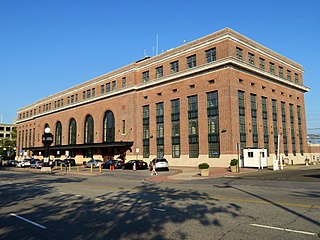
New Haven Union Station is the main railroad passenger station in New Haven, Connecticut. It is the third such station in the city of New Haven, preceded by both an 1848 built station in a different location, and an 1879 built station near the current station's location. Designed by noted American architect Cass Gilbert, the present beaux-arts Union Station was completed and opened in 1920 after the previous Union Station was destroyed by fire. It served the New York, New Haven and Hartford Railroad for the next five decades, but fell into decline following World War II along with the United States railroad industry as a whole.

Fordham station, also known as Fordham–East 190th Street station, is a commuter rail stop on the Metro-North Railroad's Harlem and New Haven Lines, serving Fordham Plaza in the Fordham neighborhood of the Bronx, New York City. The platforms are situated just below street level and feature two expanded side platforms that serve eight cars each, on the outer tracks. The station building sits above the tracks on the Fordham Road overpass, and still bears the name New York Central Railroad on its facade. The station is among the busiest rail stations in the Bronx.

White Plains station is a commuter rail stop on the Metro-North Railroad's Harlem Line, located in White Plains, New York. With 9,166 daily commuters as of 2006, White Plains is the busiest Metro-North station in Westchester County, the busiest non-terminal or transfer station on the Metro-North system, and the first/last stop outside New York City on most upper Harlem Line express trains.

Stamford station, officially known as the Stewart B. McKinney Transportation Center or the Stamford Transportation Center, is a major railroad station in the city of Stamford, Connecticut, serving passengers traveling on Metro-North Railroad's New Haven Line, Amtrak's Northeast Corridor, and CTrail's Shore Line East. In addition, it is also a major bus terminal for Greyhound, Peter Pan, and CTtransit buses. In 2018, the station averaged over 15,000 Metro-North boardings on weekdays, making it the busiest station on the system aside from Grand Central Terminal. Its official name honors politician Stewart McKinney.
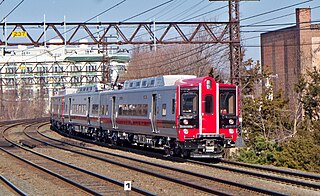
The New Haven Line is a 72.7 mi (117.0 km) commuter rail line operated by the Metro-North Railroad in the U.S. states of New York and Connecticut. Running from New Haven, Connecticut, to New York City, the New Haven Line joins the Harlem Line in Mount Vernon, New York, and continues south to Grand Central Terminal in Manhattan. The New Haven Line carries 125,000 passengers every weekday and 39 million passengers a year. The busiest intermediate station is Stamford, with 8.4 million passengers, or 21% of the line's ridership.

Providence station is a railroad station in Providence, Rhode Island, served by Amtrak and MBTA Commuter Rail. The station has four tracks and two island platforms for passenger service, with a fifth track passing through for Providence and Worcester Railroad freight trains. It is now the 11th busiest Amtrak station in the country, and the second-busiest on the MBTA Commuter Rail system outside of Boston.

Springfield Union Station is a train and bus station in the Metro Center area of Springfield, Massachusetts. Constructed in 1926, Springfield Union Station is the fifth-busiest Amtrak station in the Commonwealth, and the busiest outside of Greater Boston.

Getty Square is the name for downtown Yonkers, New York, centered on the public square. Getty Square is the civic center, central business district, and transit hub of the City of Yonkers. A dense and growing residential area, it is located in southern Westchester County, New York. The square is named after prominent 19th-century merchant Robert Getty.

Harrison station is a commuter rail station on the Metro-North Railroad New Haven Line, located in Harrison, New York, United States. During peak hours, some local trains originate or terminate here as opposed to locals from Stamford. The station has two high-level side platforms, each 10 cars long, serving the outer tracks of the four-track Northeast Corridor.
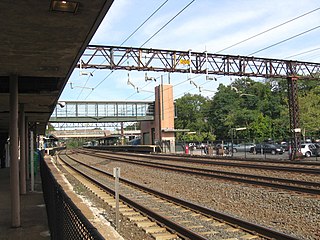
Rye station is a commuter rail stop on the Metro-North Railroad New Haven Line, located in the city of Rye, New York. The station has two side platforms, each ten cars long, serving the outer tracks of the four-track line.

Bridgeport station is a shared Amtrak, Metro-North Railroad, and CTrail train station along the Northeast Corridor serving Bridgeport, Connecticut and nearby towns. On Metro-North, the station is the transfer point between the Waterbury Branch and the main New Haven Line. Amtrak's inter-city Northeast Regional and Vermonter service also stop at the station, as do some CTrail Shore Line East trains. In addition the transfer point for Greater Bridgeport Transit Authority buses, the departure point for the Bridgeport & Port Jefferson Ferry across Long Island Sound to Port Jefferson, New York, and both the Total Mortgage Arena and the Hartford Healthcare Amphitheater are located adjacent to the station.

Old Saybrook station is a regional rail station in Old Saybrook, Connecticut. It is served by both Amtrak Northeast Regional intercity trains and CTrail Shore Line East commuter service.

New London Union Station is a railroad station on the Northeast Corridor located in downtown New London, Connecticut, United States. Union Station is a station stop for most Amtrak Northeast Regional trains and all CTrail Shore Line East commuter rail trains, making it the primary railroad station in southeastern Connecticut. It serves as the centerpiece of the Regional Intermodal Transit Center, with connections to local and intercity buses as well as ferries to Long Island and Fishers Island, New York, and Block Island, Rhode Island. The station has one side platform and one island platform serving the two-track Northeast Corridor; the latter platform also serves a siding track that connects to the New England Central Railroad mainline.
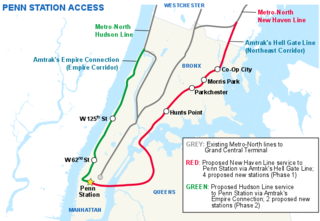
Penn Station Access (PSA) is a public works project underway by the Metropolitan Transportation Authority in New York City. The goal of the project is to allow Metro-North Railroad commuter trains to access Penn Station on Manhattan's West Side, using existing trackage owned by Amtrak. Metro-North trains currently terminate exclusively at Grand Central in Midtown Manhattan.
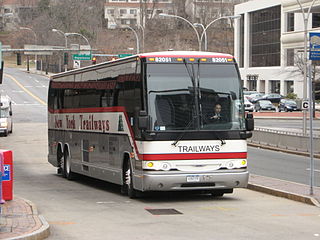
The White Plains TransCenter is an intermodal transit center in White Plains, New York. It serves as a terminal/transfer point for many Bee-Line Buses, as well as intercity buses, and taxicabs. The terminal is located along Ferris Avenue north of Hamilton Street, diagonally across from the White Plains station of Metro-North Railroad, and includes a parking garage located next door to the railroad station, across that street. Ferris Avenue is a one-way street north of Main Street, and is flanked by northbound and southbound buses only lanes between Hamilton Street and Water Street.

The Hell Gate Line is the portion of Amtrak's high-speed Northeast Corridor between Harold Interlocking in Sunnyside, Queens, and Shell Interlocking in New Rochelle, New York, within the New York metropolitan area.





























